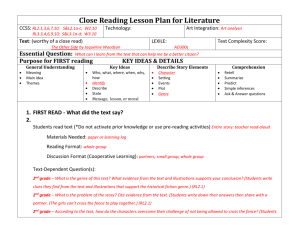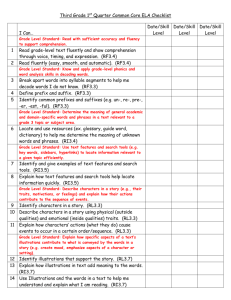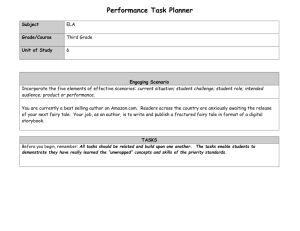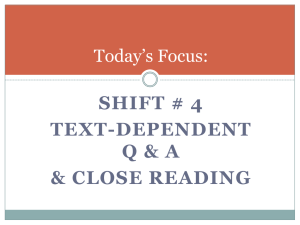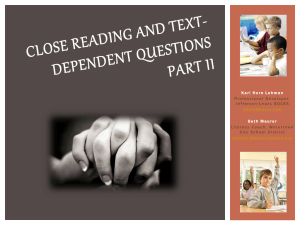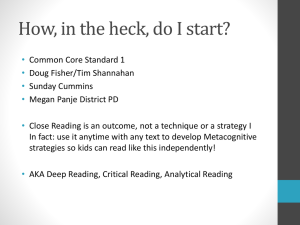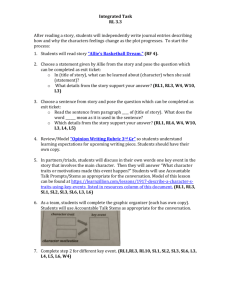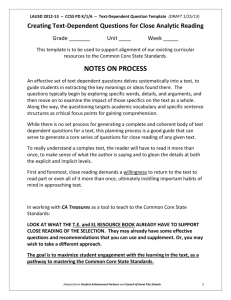My Very Own Room Lesson
advertisement
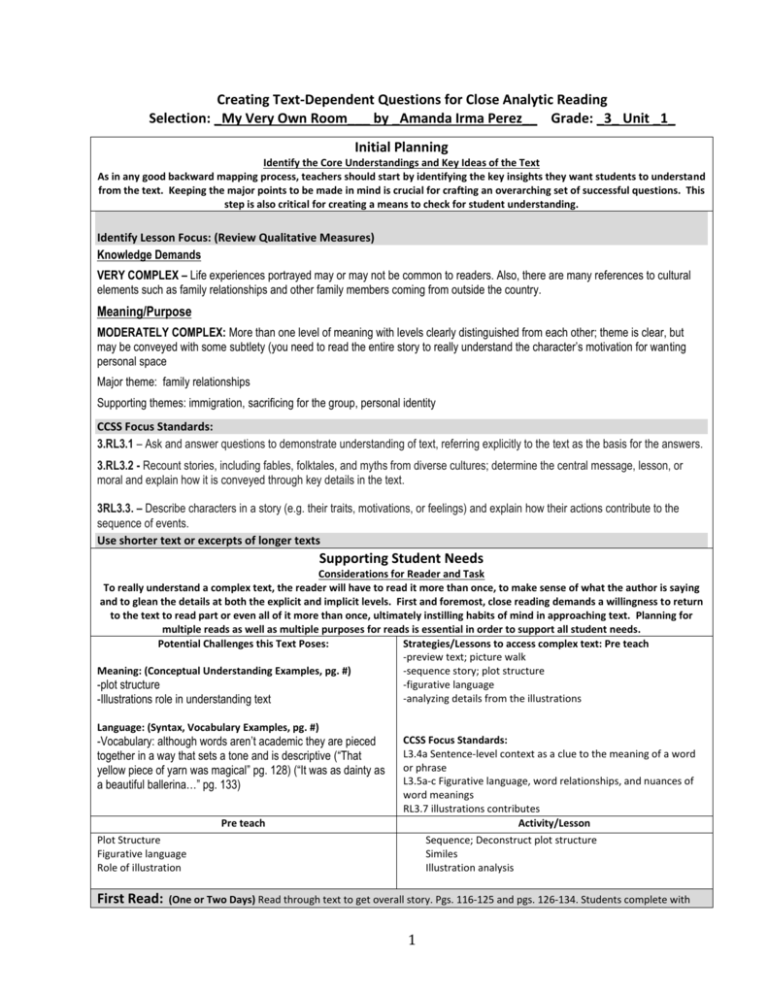
Creating Text-Dependent Questions for Close Analytic Reading Selection: _My Very Own Room___ by _Amanda Irma Perez__ Grade: _3_ Unit _1_ Initial Planning Identify the Core Understandings and Key Ideas of the Text As in any good backward mapping process, teachers should start by identifying the key insights they want students to understand from the text. Keeping the major points to be made in mind is crucial for crafting an overarching set of successful questions. This step is also critical for creating a means to check for student understanding. Identify Lesson Focus: (Review Qualitative Measures) Knowledge Demands VERY COMPLEX – Life experiences portrayed may or may not be common to readers. Also, there are many references to cultural elements such as family relationships and other family members coming from outside the country. Meaning/Purpose MODERATELY COMPLEX: More than one level of meaning with levels clearly distinguished from each other; theme is clear, but may be conveyed with some subtlety (you need to read the entire story to really understand the character’s motivation for wanting personal space Major theme: family relationships Supporting themes: immigration, sacrificing for the group, personal identity CCSS Focus Standards: 3.RL3.1 – Ask and answer questions to demonstrate understanding of text, referring explicitly to the text as the basis for the answers. 3.RL3.2 - Recount stories, including fables, folktales, and myths from diverse cultures; determine the central message, lesson, or moral and explain how it is conveyed through key details in the text. 3RL3.3. – Describe characters in a story (e.g. their traits, motivations, or feelings) and explain how their actions contribute to the sequence of events. Use shorter text or excerpts of longer texts Supporting Student Needs Considerations for Reader and Task To really understand a complex text, the reader will have to read it more than once, to make sense of what the author is saying and to glean the details at both the explicit and implicit levels. First and foremost, close reading demands a willingness to return to the text to read part or even all of it more than once, ultimately instilling habits of mind in approaching text. Planning for multiple reads as well as multiple purposes for reads is essential in order to support all student needs. Potential Challenges this Text Poses: Strategies/Lessons to access complex text: Pre teach -preview text; picture walk Meaning: (Conceptual Understanding Examples, pg. #) -sequence story; plot structure -figurative language -plot structure -analyzing details from the illustrations -Illustrations role in understanding text Language: (Syntax, Vocabulary Examples, pg. #) -Vocabulary: although words aren’t academic they are pieced together in a way that sets a tone and is descriptive (“That yellow piece of yarn was magical” pg. 128) (“It was as dainty as a beautiful ballerina…” pg. 133) Pre teach CCSS Focus Standards: L3.4a Sentence-level context as a clue to the meaning of a word or phrase L3.5a-c Figurative language, word relationships, and nuances of word meanings RL3.7 illustrations contributes Activity/Lesson Plot Structure Figurative language Role of illustration First Read: Sequence; Deconstruct plot structure Similes Illustration analysis (One or Two Days) Read through text to get overall story. Pgs. 116-125 and pgs. 126-134. Students complete with 1 partner/small group a plot structure graphic organizer. The main ideas and key details need to be identified for the 1st read for general understanding. Students retell story with partner. (RL3.1) Close Reads Create Coherent Sequence of Text-Dependent Questions Create Coherent Sequences of Text-Dependent Questions – Start Small to Build Confidence The opening questions should help orient students to the text, and be specific enough to answer so students gain confidence. The sequence of questions should not be random but should build toward more coherent understanding and analysis to ensure that students learn to stay focused on the text to bring them to a gradual understanding of its meaning. Think of ways to maximize student engagement. Close Read I Learning Focus: Cultural elements role in family dynamics Focus CCSS: 3.RL3.1, 3.RL3.2 Text-Dependent Questions Evidence-Based Answers/Pg. # Who lives in the house? Their large family and visitors, p. 119 The author writes “There was always a long line to use the bathroom, but the toilet seat was always warm.” (pg. 119) What was the author trying to convey? Use the illustration and phrases of the text to support your answer. Pg. 118-119 Illustration of crowded bed 1st line: I woke up one morning… pg. 119 Our tiny house shared by 8 of us….relatives came from Mexico… Why do they receive visitors? Temporary housing until employment is found, p. 119 What impact does housing visitors have on family life? Cite evidence from text. Why does the author compare the family to a “mighty team of powerful ants”? Cite evidence. Pg. 123 storage of family items Re-read paragraph on pg. 130. Compare and contrast Blue Chip stamps and money. How does this symbolize, or represent the idea of family sacrifice? Pg. 130 “They were like little prizes that could be used as money at special stores.” Pg. 133 shows that they pulled resource together to get girl lamp Pg. 126-127 examples of family helping each other Close Read II. Learning Focus: Families collaborate to help each other Focus CCSS: 3.RL3.2, 3.RL3.1, and 3RL3.3 Text-Dependent Questions Evidence-Based Answers/Pg. # Study the illustration on pg. 121. What do you think is happening in this illustration? How does the author show what the characters’ are feeling. How does Mama respond to her about having She wants to be alone. Reflecting. Mom is looking at her own wondering if she’s ok. Worried about her daughter. Father is unaware. (Note the halo on mother.) Mama explains that she needs to save family 2 her own room? What makes her change her mind? How would you describe the girl’s relationship with her mom? Cite evidence from the text. How would you describe the family relationships? What is the author’s message in telling the story? belongings that might be needed some day p. 123 “Then she saw the determination on my face and the tears forming in my eyes” (p. 124, part 1) Loving, caring, etc…She understands her daughter… Pg. 122 Mom comes to see her in the storage Pg. 124 Sees determination and allows her to move into storage room Pg. 133 She reads her mind and calms her worries They take care of each other and work together to help the girl Pg. 134-5 reads to siblings p. 128-9 measuring bed pg. 126-7 paint room Families help each other. Checking for Understanding How will you know that learning has occurred? Planning for a means to check student understanding is crucial. Refer back to the Lesson Focus to plan intentionally to check for student understanding. Describe how you will check for student understanding: Written recount with message What is the author’s message and how is it developed in the story? Cite specific examples. TEACHER PROVIDES DEFINITION not enough contextual clues provided in the text Vocabulary KEY WORDS ESSENTIAL TO UNDERSTANDING Words addressed with a question or task Flour sacks pg. 122 Sewing machine pg. 123 WORDS WORTH KNOWING General teaching suggestions are provided in the Introduction Separate pg. 122 Determination pg. 124 Storage pg. 122 Exact pg. 134 Ruined pg. 124 Luckiest pg. 136 Dragged pg. 126 Bulging pg. 126 3 STUDENTS FIGURE OUT THE MEANING sufficient context clues are provided in the text Jabbing pg. 118 Tiny pg. 119 Crooked pg. 121 Porch pg. 124 4
